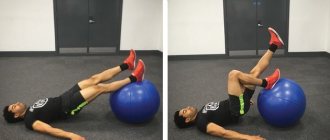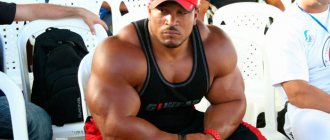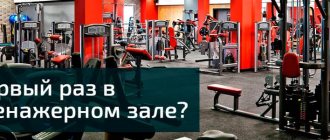A three-day mass split or, in other words, a three-day training program is one of the most popular and widespread training systems not only among beginners, but also among advanced athletes. What is a three-day training program or, in other words, a three-day weight split and how to create a training program yourself?
What is a three-day split?
A three-day split is a separate training system in which you divide all the muscles of the body into three separate groups and work each muscle group, usually once a week. For example, on Monday you train your back and biceps, on Wednesday your chest and triceps, and on Friday your legs and shoulders.
It is thanks to the enormous popularity and prevalence of three-day split programs that on Monday, Wednesday and Friday evenings there are many people in all gyms. True, most of them are beginners who practice intuitively, without adhering to a specific training scheme. Of course, this is a path to nowhere, marking time. Therefore, I always say that you need to stick to a training program and keep a training diary.
How many days a week do you train?
For the correct pace of training, a classic combination is recommended for beginners - 3 days of hard training per week involving all muscle groups. With such intensity, the body will have time to pump up and recover. The combination is called the term “split” - a training plan for 3 days. A split involves performing exercises in three sets of eight to ten repetitions with three-minute breaks between sets. Before starting classes, a fifteen-minute warm-up is required, followed by pumping - the first exercise from the complex is repeated twenty times with a small weight to warm up and pump blood to the muscles. The following elements are performed with working weights. The duration of the workout should not be more than one and a half hours.
We recommend reading: How to increase a person’s height at 17 years old
Selecting projectile weight
If you are just starting to exercise, or have had a long break, you should not use maximum weights. In this case, there is a high probability of injury.
In addition, if you are new to training, you first need to develop technique, and with heavy weights this is very difficult to do.
First, the muscles must learn the correct pattern of movement and get used to the load. After this, you can build up a lot of weights - after all, in order to make muscles grow, you still need to work with full dedication, and you can’t do this without really heavy weights.
Read this article on how to increase weight in exercises such as the bench press.
When you get to this stage, the weight of the apparatus in each exercise should be such that you work the target muscles to failure for the required number of repetitions. Ideally, at the end of each set you should feel like you can't do any more reps.
Warm-up is required
During the first 5-10 minutes before starting the training, you need to warm up. It helps minimize the risk of injury. This is especially important for those who have a history of sports injuries. The warm-up begins with light cardio, then moves on to the joints.
To prepare for your workout, you can perform several basic exercises with minimal weight.
Suitable for warm-up:
- jumping rope;
- running on a treadmill;
- pushups;
- weighted squats;
- pull-ups on the horizontal bar.
Important: the warm-up should not exhaust you - it only prepares you for the basic load.
Feelings while doing the exercise
While doing the exercises, you need to mentally concentrate on the work of the target muscles.
For example, if you are doing a barbell clean, you should focus your attention on the pectoral muscles and feel how they do their job, taking the lion's share of the load during the rise and slow, controlled lowering of the apparatus. This is a very important point that must be kept in mind in order to get really good results from your training.
If you're just starting out and your muscles are doing a lot of hard work that they're not used to, they'll be pretty sore in the first few weeks. This is absolutely normal, but the pain goes away over time.
In order to avoid pain or simply reduce it to a minimum, you need to enter the training process as smoothly as possible - you can start with a light half-hour workout with minimal weights, and then gradually increase the size of the weights.
Number of approaches and repetitions
The gym training program for men is based on 3-4 sets of each exercise, 8-12 repetitions. The specific number of repetitions is determined by taking into account that the last 2-3 should always be harder.
If 15 repetitions are already easy, you can take more weight.
We recommend reading: How to pump up your side press at home
The optimal break between approaches is 1.5-2 minutes. It has the same purpose as resting 1-3 days between workouts.
Content
- 1 Features of a three-day split
- 2 Creating a three-day split
- 3 Program 1 3.1 Workout 1. Monday
- 3.2 Workout 2. Wednesday
- 3.3 Training 3. Friday
- 3.4 Explanations for program 1
- 4.1 Workout 1. Monday
- 6.1 Conclusion
Muscle recovery
The concept of muscle recovery includes not only the renewal of energy reserves, but also the reconstruction of its cells. To conduct effective training, athletes use two rules:
- one muscle group is trained one day a week;
- the pause between workouts ranges from 48 to 96 hours.
This break allows the body to produce glycogen to replenish lost reserves. Cell restoration occurs within about two weeks - it depends on the characteristics of the body. The training program for 3 days a week provides not only intensive training, but also proper rest.
Who is suitable for split training?
Split training is suitable for athletes who have a certain athletic level, when training for all muscle groups becomes insufficiently effective. Split training is also perfect for bodybuilders who deeply work each muscle using different training methods and a whole range of exercises. But this type of training should not be recommended for beginners until the body has adapted to physical activity. And the amount of load that split training provides is also useless for beginners or athletes after a long break in training.
Option A training program 3 times a week
A gym workout program should work all muscles. The emphasis is on basic exercises. Minimum isolated, maximum basic elements.
The training regime in the gym for girls will be exactly the same, despite gender differences. But their weight does not grow so noticeably (we are talking about muscles, not fat, because it is usually easier for girls to gain weight than for guys). In general, it is better for girls not to focus solely on gaining muscle mass and to fall in love with regular fitness.
A training program for gaining muscle mass might look like this.
First day: legs and shoulders
- Cardio and warm-up.
- Barbell squats: 5 sets of 5-6 reps.
- Leg press: 3 sets of 8–10 reps with maximum weights.
- Lunges with dumbbells or leg extensions in the machine: 3 sets of 10 repetitions.
- Bench press sitting behind the head: 4 sets of 6-8 repetitions.
- Abdominal work: hanging leg raises with weights, 3-4 sets of 10 repetitions (you can hold a dumbbell between your feet, bend your knees slightly).
Day two: back and biceps
- Cardio and warm-up.
- Hyperextension: 3 to 15 without weight with a straight back.
- Deadlift: 5 x 5-6 with maximum weights.
- Upper block rows to the chest: 3 to 8.
- Bent-over rows of a T-bar or dumbbell to the belt: 4 to 8.
- Barbell for biceps: 4 to 6.
- Hammer: 2 to 10.
Day Three: Chest and Triceps
- Cardio and warm-up.
- Bench press: 4–5, 5–6 repetitions.
- Bench press on a bench with an incline of 30 degrees: 3 x 8 times.
- Bringing your arms together in a crossover to the bottom of your chest: 2 x 10 times.
- Arm extension in block: 3 to 10.
- Abs: Roman chair crunches: 4 x 10 times with weight.
You need to rest for 1-2 minutes between sets. If you are not rested enough, you will not be able to fully complete the set.
Weights should be maximum, no pumping, no cheating, pay close attention to your technique.
We recommend reading: How to learn to do pull-ups on a horizontal bar
Those with back problems should eliminate the deadlifts and squats. The latter can be replaced with Smith squats, a HAKK machine, or just a leg press.
What exercise you do depends on the severity of your back condition. If acute pain or discomfort occurs when bending over, it is better not to tempt fate. Either you were doing squats and deadlifts incorrectly, or you simply shouldn't be doing them (at least not in the near future).
Food for mass
During this effective 12-week training, you will gain muscle mass and some fat, and also significantly increase muscle strength.
Increase volumes gradually to get maximum benefits. A much easier option is to lose some fat after training rather than trying to achieve significant results while in a deficit.
If the weight persists, here are some simple ways to add a good amount of calories to your diet:
- Sample Item #1
- Sample Item #2
- Sample Item #3
- Butter
- Cream cheese
- Sour cream
- Whole milk
- Cream
- Cheese in combination with any food
- Protein shakes
- Peanut butter
- Olive oil
- Extra salad dressing
All these products allow you not only to diversify your diet. but also add a significant amount of healthy fats. When achieving a goal, this option is more preferable than going to McDonald's.
By eating clean and healthy, you will feel better and have more energy to exercise. Your stomach will tell you: “Thank you!”
Note: It's easy enough to cross all the boundaries, so watch your calories.
The main “focus” of this system is not training, but appropriate nutrition and recovery.
This bulking program may be a little overkill, after the end of 12 weeks you may want to cut back on your calories a bit. But the strength and muscle size gained is definitely worth it.
Option B training program 3 times a week
And another 3-day training program. The second option is more designed to develop strength qualities.
Day 1
- Cardio and warm-up.
- Hyperextension: 2 to 15.
- Deadlift: 5 sets of 5 reps and a sixth set of 60% of the working weight for 15 reps.
- Bench press: 5 x 5 with heavy weight, but not maximal.
- Biceps hammer: 2 x 10.
- Abs: 2 x 2 hanging leg raises with weights and 2 x 10 Roman chair crunches with a dumbbell.
Day 2
- Cardio and warm-up.
- Bench press: 3 x 5 and 2 x 3 with maximum weights.
- Hammer chest press: 3 x 8-10 with maximum weights.
- Crossover raises, dumbbell raises lying on a horizontal bench with supersets: 2 x 10 and 2 x 10 (alternate 1 set of raises with 1 set of raises).
- Extension of arms on a block: 3 x 10, 1 x 8, 1 x 6, 1 x 4 - we make a “ladder” with increasing weights. You must push yourself to the limit for the last 2 reps of each set using proper technique.
- Abs: Roman chair crunches 3 x 10 with weight.
Day 3
- Cardio and warm-up.
- Barbell squats: 5 to 5.
- Leg press: 3 x 8–10.
- Lat pulldowns or pull-ups with a narrow reverse grip: 4 to 8 with weights.
- Pullover: 2 to 10.
- Cardio: 15 minutes with 1 interval.
You can remove the deadlift and replace it with the leg press. It all depends on your physical capabilities.
Isolated exercises should be eliminated. You can change various auxiliary elements every 2 weeks, for example, bringing your arms together in a crossover to pressing dumbbells upside down, or lunges with dumbbells to straightening and bending your legs in a machine.
Creating a three-day split[edit | edit code]
You can divide the muscles of the body into three separately worked groups in various ways. For example,
- Back-biceps
- Legs-shoulders
- Chest-triceps
or
- Back-chest
- Biceps-triceps
- Legs-shoulders
or
- Chest-shoulders
- Back-triceps
- Legs-biceps
or some other way. There are many options and most of them have a right to exist. Each of them has some advantages over others. Let's look at the most popular three-day split options for beginner athletes below:
Tips for increasing program effectiveness
It is not necessary to count the number of calories every day, although this brings really good results both in losing weight and in cutting or gaining muscle mass.
Calculate your ideal sports weight!
But in order for the described program for 3 daily workouts for men to bring the best results, it is enough to follow a few rules:
- Number of meals – 5-6 times a day: 3-4 main meals and 2-3 snacks.
- Refusal of simple carbohydrates: sweets, soda, fast food, etc. They must be replaced with complex ones. These can be cereals, legumes, herbs, vegetables, grapes, whole grain bread, pasta, potatoes. Carbohydrates are needed so that the body has enough energy for training.
- In addition to complex carbohydrates, add Omega-3 fatty acids and quality protein in an amount of 2-2.2 g/kg body weight. This is enough for a positive nitrogen balance, which is necessary for muscle growth. Protein with high biological value is found in whey protein, chicken eggs, dairy products and seafood.
Don't forget about pre-workout nutrition, as proper nutrition will help increase your energy potential. If you have difficulty gaining weight and to get the maximum benefit from strength training, you can use sports nutrition. What supplements will help improve results:
- protein,
- pre-workout complexes;
- creatine;
- gainers;
- isotonics;
- BCAAs.
Protein
Protein allows you to build muscle mass by providing your muscles with the necessary amount of amino acids. You can drink protein before and after training.
Pre-workouts
Pre-workout supplements, as the name suggests, are taken before training, approximately 20-40 minutes. Their main purpose is to provide the body with energy so that the workout is as productive as possible. We suggest studying the ratings and tips for choosing pre-workout complexes.
Creatine
Creatine provides an increase in lean muscle mass, i.e. without subcutaneous fat deposits. Creatine is recommended to be taken after training. The supplement will also be useful on days free from physical activity. Here we recommend learning how to take creatine to gain muscle mass.
Gainers
Gainers are supplements with an average protein content of 30% and carbohydrates of 70%. The purpose of the intake is to provide the body with energy and increase the amount of calories consumed without resorting to overeating. Find out which gainer is best and about the most popular supplements in this category, True Mass and True Mass 1200.
BCAA is the most popular amino acid complex. They slow down catabolism, which has a positive effect on muscle growth, and also helps to recover faster.
Features of a three-day split[edit | edit code]
In a three-day split, the body's muscles are divided into three groups, and each of them is trained once during a specific microcycle, usually once a week. In addition to the weekly one, microcycles with a different number of days can be planned, for example, 8 or 9 days. Many athletes, both beginners and advanced, train using a three-day split. Here we will look at a three-day split for beginners, which has some differences from splits for advanced athletes. So, the training within the framework of a two-day split is completed and its possibilities are basically exhausted, and psychologically it is quite difficult to follow the same program for a long time. The most correct seems to be the transition from a two-day split to a three-day one. It is characterized by working out each muscle group only once during a certain microcycle, in our case once a week. This will be enough if you increase the load on the muscle groups being worked. The load will be increased both due to increased working weights in the exercises, and due to an increase in the number of exercises themselves for each muscle, as well as due to a greater number of working approaches to it.
General recommendations[edit | edit code]
You can still come up with and implement many three-day splits, and all will have some advantages or disadvantages. A guideline here may be to place the lagging muscle group on a separate training day and draw up a split according to this condition. Consideration of them is beyond the scope of this article. The general training rules at this stage are standard. General warm-up and light stretching to prepare the body for power loads. A special warm-up in one or two approaches with light weight before performing each exercise. The pace of execution is average, without jerking or beating the barbell against the chest. Rest time between sets is 2-3 minutes.
Recommendations for mesomorphs
This category includes people who have naturally developed muscles, a broad chest, and a long torso. They have a great increase in muscle mass. People with this body type find it easiest to develop a beautiful body.
A split for gaining weight for a mesomorph is based on the following rules:
- It is recommended to repeat the exercise 8–12 times. Approaches need to be completed 6-8.
- It is allowed to include special exercises in the lesson aimed at improving muscle forms.
- It is recommended to work out 2-3 groups of muscle tissue in one lesson.











